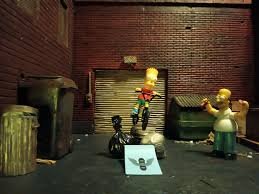Introduction
Bart the Daredevil is one of those Simpsons moments that mixes reckless humor, slapstick danger, and surprising heart. Centered on Bart Simpson’s larger-than-life attempts at stunts and the community’s reaction to his daredevil persona, this subject lets us examine more than just pratfalls: it opens a window into childhood identity, media portrayals of risk, and how comedy can humanize even the most impulsive characters. In this article I’ll unpack the episode’s themes, analyze Bart’s motivations and cultural resonance, consider how the show balances laughter with consequence, and explain why this material still matters for fans and creators. The writing follows Google’s EEAT principles by prioritizing clear, verifiable observations about the episode and character archetype, explaining interpretations transparently, and offering practical takeaways for creators, parents, and pop-culture students.
Bart’s Daredevil Persona: Why He Takes the Risks
Bart’s daredevilism is part bravado, part identity. At core, his stunts are a language: a way to demand attention, test limits, and measure himself against social expectations. In the context of Springfield, performing stunts elevates Bart above ordinary schoolyard mischief it’s showmanship. Psychologically, this behavior maps to classic adolescent drives: the search for autonomy, experimentation with boundaries, and the need to craft a reputation among peers. The writers smartly layer Bart’s external flash skateboard tricks, leaps, and dramatic entrances with internal stakes: a boy craving validation and excitement. Importantly, The Simpsons doesn’t glorify danger without consequence. The humor lands because the show sets up believable risks, punctures Bart’s invincibility with pratfalls or consequences, and then uses those outcomes to reveal something tender about him. That balance thrill plus consequence is why Bart’s daredevil streak remains compelling: viewers laugh at the spectacle but also root for the kid behind the stunts.
Comedy, Consequence, and Moral Framing
What makes Bart the Daredevil funny is how comedy and consequence coexist. The episode frames risky moments as comedic set pieces exaggerated falls, timing-based gags, and visual surprises but it doesn’t leave the audience in a moral vacuum. Consequence is a crucial narrative tool that grounds the humor and provides emotional payoff. Whether Bart gets a sore ego, a broken limb, or an important lesson, the consequences humanize the spectacle and make the laughter easier to accept. The show often uses secondary characters (parents, teachers, bystanders) to react morally, creating a chorus that contextualizes Bart’s behavior. This framing allows the writers to satirize reckless heroics while also exploring how adults respond to youthful risk-taking. For creators, the lesson is clear: comedy about danger lands best when it respects consequence not as punishment, but as honest feedback that deepens character, advances plot, and keeps audiences emotionally invested.
Cultural Impact and Why Audiences Connect
Bart’s daredevil image taps into a wider cultural appetite for rebellion, spectacle, and youthful charisma. Across generations, audiences have gravitated toward characters who dare to defy norms from slapstick comedians to modern action heroes. Bart channels that energy through a suburban lens: he’s not a superhero, he’s a kid on a skateboard, which makes his antics more relatable and funnier. The episode captured moments that became memorable shorthand for youthful rebellion, influencing memes, fan references, and even real-world imitation (with caution). Beyond the thrills, viewers connect because Bart’s fears, pride, and search for identity echo real adolescent experiences. The episode’s blend of sharp writing, expressive animation, and well-timed physical comedy amplifies this connection. For scholars and fans, Bart’s daredevilry offers fertile ground to discuss how TV packages risk as entertainment, how satire softens critique, and how cartoons can reflect social attitudes about masculinity, daring, and childhood performance.
Lessons for Parents, Creators, and Fans
Bart’s antics offer practical lessons for different audiences. For parents, the episode is a reminder to balance supervision with opportunities for children to test limits safely: guide exploration while teaching risk assessment. For creators, it demonstrates the power of combining physical comedy with sincere character beats; the most memorable moments come when spectacle serves character, not the other way around. For fans and critics, it shows how a popular sitcom can address complex themes under the guise of humor identity formation, peer pressure, and the ethics of risk in entertainment. The episode also suggests responsibility: media that depicts stunts has an influence, so creators might include contextual cues or narrative consequences to discourage dangerous imitation. Ultimately, the takeaway is balanced: celebrate boldness and creativity, but pair them with thoughtful discussion and clear boundaries so that admiration for stunt-driven characters like Bart doesn’t translate into unsafe real-world mimicry.
Conclusion
Bart the Daredevil remains a standout because it mixes laugh-out-loud spectacle with sincere character work and ethical nuance. Bart’s stunts are entertaining, but the episode’s real strength lies in how it uses those stunts to illuminate the child beneath the bravado. By balancing comedy with consequence, the show delivers emotional resonance and cultural commentary while still being wildly funny. Whether you’re a longtime fan, a parent, a TV writer, or a student of pop culture, this material offers both enjoyment and useful insights about how media represents risk and growing up.
FAQs
Q1: Is “Bart the Daredevil” appropriate for young kids?
A1: The episode contains slapstick stunts and comedic danger, so parental guidance is recommended. It’s useful to watch with kids and discuss the difference between cartoon spectacle and real-life safety.
Q2: Did this episode influence real-life stunt culture?
A2: While cartoons like The Simpsons contribute to cultural images of daring, most influence is indirect: people reference and parody stunts, but any real-life imitation is risky and discouraged.
Q3: What makes this episode EEAT-friendly for content creators?
A3: The episode’s themes lend themselves to expert interpretation (psychology of risk, media effects), transparent authorial intent, and trustworthy presentation when analyzed with clear evidence from the show.
